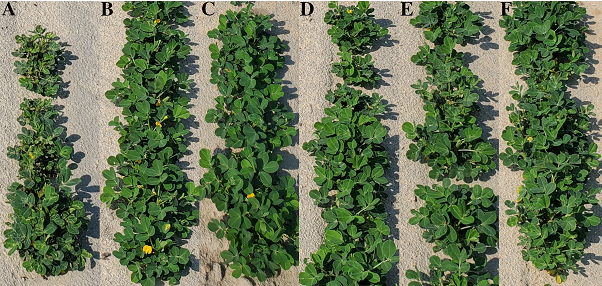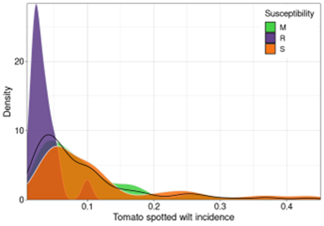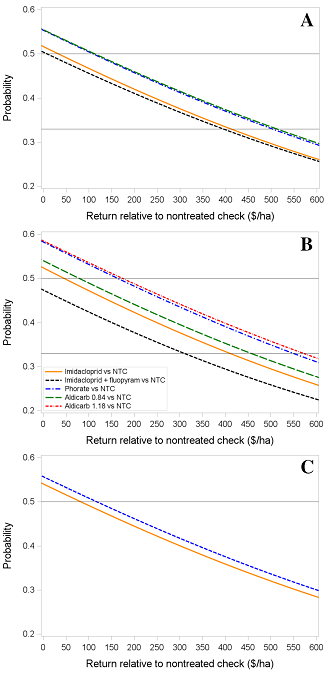Introduction
Early-season management recommendations for commercial conventional peanut production across the Virginia-Carolina and southeast regions of the U.S. integrate the application of insecticides in-furrow at planting to reduce thrips (Frankliniella spp.) injury and mitigate corresponding vectored tomato spotted wilt (TSW, caused by Tomato spotted wilt virus) infections (Anco et al. 2022; Jordan et al. 2021; Kemerait et al. 2018). Farmers have several in-furrow insecticides to select from, with aldicarb having regained registration for use in peanut in 2016. Costs of production and the anticipated benefit of an individual treatment in an overall management program continue to be relevant for selection and implementation of products and practices. Practices that extend or stretch the efficacy or value of agricultural inputs are of interest from both a resource stewardship and budget viewpoint. Pertaining to this, superabsorbent polymers (SP) have been reported to reduce leaching/increase retention of pesticides (Gubišová et al. 2022, Jing et al. 2021) (i.e., through a greater amount of product absorption) without a decrease in fungicide efficacy (Gubišová et al. 2022). Fertilizer co-applied with SP resulted in greater pine seedling growth and nutrient levels compared to seedlings treated with fertilizer alone (Mao et al. 2021). In peanut, co-application of SP with insecticide (imidacloprid or phorate) in-furrow at-planting was previously conducted across six experiments in SC and GA but was reported to have variable effects across individual experiments (Haynes et al. 2019). Consequently, further work would be required before use of SP with insecticides could be recommended in peanut.
Efficacy results comparing the profitability of individual treatments continue to bring value to end-user decision making. Previous work examined the efficacy and profitability of several common in-furrow insecticides across peanut variety susceptibility groupings relative to TSW (Anco et al. 2020) but did not include aldicarb treatment. The objective of this work was twofold: first, to determine the efficacy of insecticides (imidacloprid or phorate) applied with SP across a greater number of experiments in the context of a network meta-analysis and second, to include aldicarb in a profitability evaluation against commercial standard in-furrow insecticides.
Materials and Methods
Data from 40 experiments conducted in South Carolina (n = 38) or Georgia (n = 2) from 2009 through 2022 were organized for collective analysis. Experiment location soil types were a Barnwell loamy sand: fine-loamy, kaolinitic, thermic Typic Kanhaplundults (Edisto Research and Education Center in Blackville, SC, 33.364°N, -81.329°E), a Norfolk loamy sand: fine-loamy, kaolinitic, thermic Typic Kandiudults (Pee Dee Research and Education Center in Florence, SC, 34.289°N, -79.738°E), a Tifton loamy sand: fine-loamy, kaolinitic, thermic Plinthic Kandiudults (Coastal Plain Experiment Station in Tifton, GA, 31.480°N, -83.522°E), and a Noboco loamy sand: fine-loamy, siliceous, subactive, thermic Oxyaquic Paleudults (commercial field in Fairfax, SC, 32.976°N, -81.231°E). Experimental planting dates were from late April to late May. Similar to Anco et al. 2020, cultivars were categorized according to their relative TSW susceptibility as susceptible, moderately susceptible, or resistant based on field performance (Anco et al. 2022). The susceptible group included Contender, FloRun 157, Phillips, and TUFRunner 511; the moderately susceptible group was comprised of CHAMPS, FloRun 331, Georgia-06G, Georgia-09B, Georgia-16HO, and NCV-11; cultivars included in the resistant group were Bailey, Sugg, Sullivan, Georgia-12Y, TifNV-High O/L, and TUFRunner 297. To be included in the analysis, individual experiments needed to contain at least two insecticide treatments. Treatment representation across experiments, years, and relative cultivar susceptibility level to TSW is shown in Table 1. Experiments were compiled to obtain data on stand (peanut plants/m), thrips injury (0 to 10 scale (Brandenburg et al. 1998)), proportion TSW incidence (Culbreath et al. 2008), and yield (kg/ha). Stand counts were grouped into one of two categories based on days after planting (DAP) each assessment was made: 9 to 14 and 15 to 32 DAP. Peanut management within experiments was based on Extension recommendations (Anco et al. 2022). Peanut were inverted near approximate physiological maturity (Boote 1982) at a reasonable time for each experiment. Pod yield measurements were collected with a Hobbs two-row combine fitted with a load cell basket or a Lilliston two-row combine with bagger attachment, with moisture standardized to 10%.
Data were analyzed according to a meta-analysis on the raw data (one-stage individual patient data) (Simmonds et al. 2005; Thompson and Higgins 2002; van Houwelingen et al. 2002). The GLIMMIX procedure of SAS (SAS 9.4, Cary, NC) was used to analyze the data according to the following overall model:
Yijkl = Ti + TiGj + Sk + RlSk + TiSk + I + eijkl[1]
where Yijkl is the response variable (stand, thrips injury, TSW incidence, or yield) of the ith treatment and jth susceptibility group of the kth study and lth replicate, Ti is the fixed effect of the ith treatment, TiGj is the fixed effect of the ith treatment and jth susceptibility group, Sk is the random effect of the kth study, RlSk is the random effect of the lth replicate of the kth study, TiSk is the random effect of the ith treatment of the kth study, I is an intercept, and eijkl is the residual. Stand and pod yield were modeled according to a gamma distribution. Thrips injury (0 to 10 scale scaled to 0 to 1) and TSW incidence (proportion) were modeled according to a beta distribution. Treatment least squares means were separated according to Fisher’s protected LSD at the 0.05 probability level and are reported on the data scale (inverse-linked). The TiGj term was excluded from the stand and thrips injury models, resulting in their corresponding treatment estimates being pooled over cultivar susceptibility groups (i.e., to exclude cultivar genetics as a potential source of variation from the evaluation of early season insecticide effects). For TSW incidence and yield results, treatment means were separated within each cultivar susceptibility group (i.e., TiGj term retained), with the Ti term removed for parsimonious simplification.
Inconsistency (Madden et al. 2016; Piepho 2014; Piepho et al. 2015) of the model across data-populated experiment-treatment compositions (structures) was evaluated using the following formula:
Yijkl = TiGj + Dk + DkTiGj + Sk + RlSk + TiSk + I + eijkl[2]
where Dk is the fixed effect of the treatment composition of the kth study, DkTiGj is the fixed effect of the kth study’s treatment composition on the ith treatment and jth cultivar susceptibility group, and remaining terms are as described for equation 1. Assessment for inconsistency was similarly conducted for an expanded version of the analysis that incorporated data from eight cultivar phenotype experiments (e.g., pod yield trials conducted in Blackville, SC from 2016 to 2022) that examined multiple cultivars of varying TSW susceptibility within the context of a uniform in-furrow insecticide treatment (imidacloprid, n = 3 trials; phorate, n = 5 trials) but otherwise met the previously described screening criteria for TSW incidence and pod yield. This allowed a quantitative determination of a contaminating effect of study data with exclusively indirect (Lu and Ades 2004) treatment comparisons (i.e., varying cultivar susceptibility groups under a shared in-furrow insecticide) on the direct comparisons (i.e., in-furrow insecticide treatments) of primary interest.
The projected probability of a treatment having a greater yield or return over the nontreated control was calculated as described previously (Anco et al. 2020; Paul et al. 2008; van Houwelingen et al. 2002). Peanut contract price was set at $524/1000 kg. Formulated product costs were obtained from local distributors in 2022 and estimated at $14.33/kg, $37/L, $155.54/L plus $37/L, and $8.66/kg for aldicarb (AgLogic 15G), imidacloprid (e.g., Macho or Nuprid), fluopyram (Velum) plus imidacloprid, and phorate (Thimet 20G), respectively. Imidacloprid or phorate co-applied with SP were excluded from projected profitability calculations due to their corresponding yields not being significantly different compared to individual application of those treatments.
Results and Discussion
Treatments varied in stand count from 9 to 14 DAP (P < 0.0001) but not from 15 to 32 DAP (P = 0.2087) (Table 2). At 9 to 14 DAP, all treatments exhibited less emerged plants/m than the nontreated check (NTC, 8.4 plants/m). The treatments with the least emerged plants included aldicarb at 1.12 kg ai/ha or 0.84 kg ai/ha, imidacloprid plus fluopyram, and imidacloprid plus SP (7.0 to 7.6 plants/m). Stand counts were not different when either imidacloprid or phorate were applied with SP compared to those ai applied alone (P > 0.35), corroborating previous results (Haynes et al. 2019). By 15 to 32 DAP, all treatments exhibited comparable stands between 9.9 and 10.8 plants/m.
Thrips injury varied among treatments at P < 0.0001 (Table 2). All treatments exhibited less injury compared to the NTC. Treatments with aldicarb had the least thrips injury (1.7 to 1.9) and were anecdotally noted to have the most vigorous canopy growth at this time (Figure 1). Similar to Brandenburg et al. 2019, imidacloprid- and phorate-based treatments exhibited a similar level of thrips injury management (2.8 to 3.1). While these results were similar to those of Brandenburg et al. 2021 when in-furrow treatments were followed by an application of acephate, results from that study in the absence of acephate indicated phorate to confer a slight yet statistical advantage of phorate to imidacloprid as well as of imidacloprid to imidacloprid plus fluopyram. As with the stand count data, thrips injury associated with imidacloprid or phorate applied alone was not different from that of the corresponding treatment including SP (P > 0.27).
Representative images of thrips injury for peanut planted (A) without insecticide or treated in-furrow at planting with (B) aldicarb 0.84 kg ai/ha, (C) aldicarb 1.18 kg ai/ha, (D) imidacloprid 0.36 to 0.40 kg ai/ha, (E) imidacloprid (0.35 kg ai/ha) plus fluopyram 0.24 kg ai/ha, or (F) phorate 1.05 kg ai/ha. Picture was taken 34 days after Georgia-06G peanut was planted 28 April 2022 in Blackville, SC.
Incidence of TSW varied among treatments for each of the three susceptibility groups examined (P < 0.0001, Table 3). Within each susceptibility group, phorate treatment consistently exhibited the least TSW incidence. Incidence following phorate treatment was less than the NTC for the susceptible and moderately susceptible cultivar data, but it was not significantly different from the NTC within the resistant cultivar results. Conceptually, this fits with the understanding that the resistant cultivars’ genetic resistance reduced overall TSW development to the extent that further suppression subsequent to in-furrow insecticide application was not evident (Anco et al. 2020). Also within the resistant cultivar data, imidacloprid-based treatments were associated with a significant increase in TSW compared to the NTC, where this increase was not significant for the susceptible or moderately susceptible cultivar groups. Imidacloprid has previously been reported to increase TSW (Culbreath and Srinivasan 2011, Kemerait et al. 2018, Srinivasan et al. 2017). Co-application with SP did not affect TSW incidence of imidacloprid (P > 0.7) or phorate (P > 0.08) treatments. Aldicarb treatment was generally associated with a moderate level of TSW incidence that was between imidacloprid and phorate.
Pod yield varied by treatment for the susceptible (P = 0.0468) and moderately susceptible (P < 0.0001) groupings (Table 3), where phorate (with or without SP) or aldicarb treatments exhibited greater yield compared to the NTC. Imidacloprid-based treatments did not statistically improve yield compared to the NTC among these data. Treatment pod yield was not significantly different among the resistant cultivars (P = 0.2209), which contrasts previous reports in which Bailey peanut (Isleib et al. 2011) treated with imidacloprid, imidacloprid plus fluopyram, or phorate yielded 120 to 210 kg/ha greater than the NTC without further treatment differences across experiments from 2014 to 2020 (Brandenburg et al. 2021). Prior results from 2012 to 2014, also with Bailey, attributed a yield benefit of 500 kg/ha or 280 kg/ha following imidacloprid or phorate treatment, respectively, relative to the NTC (Brandenburg et al. 2019). These prior reports (Brandenburg et al. 2019, 2021) were associated with a lack of TSW incidence (< 5%) for individual treatments within experiments, which contrasted with the results of the current study as described in the previous paragraph (i.e., 43% of experiments exhibited > 5% TSW incidence for resistant cultivars treated with imidacloprid-based insecticide) (Figure 2), which could have contributed to the difference in reported pod yield results. Use of SP did not affect yield for imidacloprid (P > 0.62) or phorate (P > 0.37) treatments.
Models were determined to exhibit consistent (stable) performance across study-treatment compositions for the TSW incidence (P = 0.5843 and 0.0891 for Dk and DkTiGj, respectively) and pod yield (P = 0.1199 and 0.1363 for Dk and DkTiGj, respectively) dataset of screened studies as presented in Table 1. Accordingly, the results presented (Tables 2 and 3, Figure 3) are those from the screened dataset. When the screened dataset of experiments including at least two in-furrow insecticide treatments was expanded to evaluate the appropriateness of including data from cultivar yield-potential experiments where there was only a single in-furrow treatment applied, inconsistency (variation) in model results was detected. The significant interaction term, DkTiGj, for both the TSW incidence (P = 0.0187) and pod yield (P = 0.0053) models indicated that the results comparing in-furrow treatments were affected by the inclusion of experiments that had only a single in-furrow treatment. This was likewise evident when the experiment-treatment composition was grouped into one of two categories separating the presence of more than one in-furrow insecticide treatment from the presence of a single such treatment (P = 0.0005 and < 0.0001 for TSW incidence and pod yield, respectively). Functionally, the inconsistent model response in the presence of the cultivar pod yield trial data indicates those experiments contributed an unbalanced influence on the model. Conceptually, data from experiments designed to compare cultivar yield potential while attempting to minimize the effect of yield-limiting factors could contribute an upward bias among represented susceptibility group-treatment combinations (which were not further accounted for by genotype) compared to insecticide treatments not present in such experiments. Indirect estimates (i.e., treatment comparisons not represented in the same experiment) for TSW incidence from the expanded data would have increased by a range of 0.7%, whereas estimates for imidacloprid or phorate would have ranged by 3.4% to 0.9%, respectively. This was similarly manifested through yield estimates for imidacloprid from the expanded dataset being inflated by 50 to 360 kg/ha. Yield estimates associated with phorate analogously were increased by -60 to 230 kg/ha, while remaining treatment estimates would have increased by an average of 140 kg/ha (range = 65 kg/ha). Inclusion of indirect comparisons in an overall network meta-analysis has been used and can be beneficial for instances where trial data including direct comparisons is limited (Bucher et al. 1997; Higgins and Whitehead 1996; Song et al. 2003) to improve precision of treatment estimates (Higgins and Whitehead 1996), provided populations are comparable and screening criteria are maintained without (inadvertently) introducing additional confounding factors. Concerns of doing so include a potential increase in bias (Lu and Ades 2004; Song et al. 2003) and inaccurate treatment estimates (Bucher et al. 1997). The results of the inconsistency analysis herein support the original study screening criteria and reinforce the importance of the judicious evaluation of candidate study data prior to incorporation in a given meta-analysis (Bucher et al. 1997; Song et al. 2003).
Estimated probability of return for insecticide treatments relative to the nontreated check (NTC) for peanut cultivars (A) susceptible, (B) moderately susceptible, and (C) resistant to tomato spotted wilt. Treatments included aldicarb (e.g., AgLogic 15G at 0.84 kg ai/ha or 1.18 kg ai/ha, AgLogic Chemical), imidacloprid (e.g., Admire Pro, 0.36 to 0.40 kg ai/ha, Bayer CropScience), imidacloprid plus fluopyram (Velum Total, 0.35 and 0.24 kg ai/ha imidacloprid and fluopyram, respectively, Bayer CropScience), and phorate (Thimet 20G, 1.05 kg ai/ha, AMVAC Chemical Corporation).
There was a greater range in the projected profitability for treatments in the moderately susceptible group compared to the susceptible group (Figure 3). From the susceptible cultivar data, future treatment of an individual field with imidacloprid, imidacloprid plus fluopyram, phorate, or aldicarb 0.84 kg ai/ha was estimated to confer net returns over the NTC of at least $38 ($411), $11 ($392), $105 ($506), or $107 ($513)/ha, respectively, 50% (33%) of the time. For moderately susceptible cultivars, imidacloprid, imidacloprid plus fluopyram, phorate, aldicarb 0.84 kg ai/ha, and aldicarb 1.18 kg ai/ha were projected to elicit net returns above the NTC of at least $46 ($405), -$50 ($305), $168 ($549), $76 ($460), and $173 ($565)/ha, respectively, 50% (33%) of the time. While the overall pod yield results for the resistant cultivars were not significantly different by treatment, the profitability (50% of the time) relative to the NTC of treatment with phorate, $119/ha, was estimated to be slightly greater than that of imidacloprid, $86/ha.
Collectively, phorate and aldicarb exhibited the greatest and most consistent returns above the NTC. Under these conditions, profitability associated with imidacloprid plus fluopyram did not exceed that of imidacloprid alone. This may have in part been contributed by a lack of substantial numbers of economically important nematodes in planted fields (Faske and Hurd 2015, Jackson et al. 2014), in which case the profitability associated with aldicarb treatment could accordingly be anticipated to change (Minton and Morgan 1974, Smith 1972). While less objective and static to compare across individual management preferences, another important factor to consider with regard to different treatments is the value of convenience (i.e., of handling and application). Liquid formulations are easier to apply than granular formulations, and increased application of liquid over granular insecticides has been reported in recent years (Brandenburg et al. 2019, Morgan et al. 2014). Results from this work suggest that on average, treatment of cultivars susceptible to TSW with phorate or aldicarb (0.84 kg ai/ha) would be $68/ha more profitable than imidacloprid and $95/ha more profitable than imidacloprid plus fluopyram. For moderately susceptible cultivars, phorate or aldicarb (1.18 kg ai/ha) treatment was estimated to be $125/ha more profitable than imidacloprid and $221/ha more profitable than imidacloprid plus fluopyram, with aldicarb 1.18 kg ai/ha being approximately $97/ha more profitable than its lower corresponding rate of 0.84 kg ai/ha. Results indicated there was no benefit to the use of SP with either imidacloprid or phorate; use of SP with an in-furrow insecticide at-planting for peanut is consequently not recommended.
Acknowledgements
Appreciation is extended to James Thomas and Kyle Kinard for technical assistance. Support was provided by the South Carolina Peanut Board and the National Peanut Board. A portion of the seed used in these experiments was provided by Georgia Seed Development. Technical Contribution No. 7059 of the Clemson University Experiment Station. This material is based upon work supported by NIFA/USDA, under project number SC-1700592.
Literature Cited
Anco D., Marshall M., Kirk K., Plumblee M., Smith N., Mickey S., Farmaha B. and Payero J.. 2022. Peanut money-maker 2022 production guide. Clemson University Extension Circular 588. Clemson University Extension, Clemson, SC.
Anco D.J., Thomas J.S. and Monfort W.S.. 2020. Efficacy and profitability of insecticide treatments for tomato spotted wilt management on peanut in South Carolina. Plant Dis. 104:1096-1104.
Brandenburg R., Herbert Jr. D., Sullivan G., Naderman G. and Wright S.. 1998. The impact of tillage practices on thrips injury of peanut in North Carolina and Virginia. Peanut Sci. 25:27-31.
Brandenburg R.L., Jordan D.L., Royals B.R., Mahoney D.J., and Johnson P.D. 2019. Utilization of imidacloprid to control thrips in peanut in North Carolina. Peanut Science 46:8-13.
Brandenburg R., Royals B., Taylor S., Malone S., Jordan D., and Hare A. 2021. Responses of tobacco thrips and peanut to imidacloprid and fluopyram. Crop Forage & Turfgrass Mgmt. 7:e20116.
Bucher H.C., Guyatt G.H., Griffith L.E., and Walter S.D. 1997. The results of direct and indirect treatment comparisons in meta-analysis of randomized controlled trials. J. Clin. Epidemiol. 50:683-691.
Culbreath A., and Srinivasan R. 2011. Epidemiology of spotted wilt disease of peanut caused by Tomato spotted wilt virus in the southeastern U.S. Virus Res. 159:101-109.
Culbreath A.K., Tillman B.L., Gorbet D.W., Holbrook C.C., and Nischwitz C. 2008. Response of new field-resistant peanut cultivars to twin-row pattern or in-furrow applications of phorate for management of spotted wilt. Plant Dis. 92:1307-1312.
Faske T.R., and Hurd K. 2015 Sensitivity of Meloidogyne incognita and Rotylenchulus reniformis to fluopyram. J. Nematol. 47:316-321.
Gubišová, M., Hudcovicová, M., Matušinský, P., Ondreiˇcková, K., Klˇcová, L., and Gubiš, J. 2022. Superabsorbent polymer seed coating reduces leaching of fungicide but does not alter their effectiveness in suppressing pathogen infestation. Polymers 14:76.
Haynes J.M., Smith N., Culbreath A.K., Kirk K.R. and Anco D.J.. 2019. Effects of insecticides applied in-furrow with superabsorbent polymer on peanut cultivars infected with Tomato spotted wilt virus. Peanut Sci. 46:127-139.
Higgins J.P.T., Stewart L.A., Tierney J.F., Clarke M.J. and Thompson S.G.. 2005. Meta-analysis of individual patient data from randomized trials: A review of methods used in practice. Clin. Trials 2:209-217.
Higgins J.P.T., and Whitehead A. 1996. Borrowing strength from external trials in a meta-analysis. Statistics in Medicine 15:2733-2749.
Isleib T.G., Milla-Lewis S.R., Pattee H.E., Copeland S.C., Zuleta M.C., Shew B.B., Hollowell J.E., Sanders T.H., Dean L.O., Hendrix K.W., Balota M., and Chapin J.W. 2011. Registration of ‘Bailey’ peanut. [: J. Plant Registrations], 5:27–39.
Jackson C.S., Faske T.R., and Kirkpatrick T.L. 2014. Assessment of fluopyram for suppression of root-knot nematode (Meloidogyne incognita) in soybean. Pages 65-67 in: Arkansas Soybean Research Studies 2014. J. Ross, ed. University of Arkansas, Fayettville, AK.
Jing Y., Krauss M., Zschieschang S., Miltner A., Butkovskyi A., Eggen T., Kästner M., and Nowak K.M. 2021. Superabsorbent polymer as a supplement substrate of constructed wetland to retain pesticides from agricultural runoff. [: Water researc]h. 207: 117776.
Jordan D.L., Brandenburg R.L., Brown A.B., Buol G., Foote B., Roberson G.T., Shew B. and Washburn D.. 2021. Peanut Information. NC State Extension: Raleigh, NC.
Kemerait R., Culbreath A., Prostko E., Brenneman T., Tubbs S., Srinivasan R., Abney M., Monfort S., Rabinowitz A., Tillman B., Dufault N., Rowland D., Mulvaney M., Small I., Hagan A., Sarver J., Anco D., and Smith N. 2018. Peanut Rx—Minimizing Diseases of Peanut in the Southeastern United States. The 2018 Version of the Peanut Disease Risk Index. University of Georgia Extension. https://peanuts.caes.uga.edu/content/dam/caes-subsite/peanuts/docs/2018/2018-Peanut-Rx-Disease-Risk-Index.pdf
Lu G., and Ades A.E. 2004. Combination of direct and indirect evidence in mixed treatment comparisons. Statist. Med. 23:3105-3124.
Madden L.V., Piepho H.-P., and Paul P.A. 2016. Statistical models and methods for network meta-analysis. Phytopathology 106:792-806.
Mao L., Zha R., Chen S., Zhang J., Jie L., and Zha X. 2021. Mixture compound fertilizer and super absorbent polymer application significantly promoted growth and increased nutrient levels in Pinus massoniana seedlinds and soil in seriously eroded degradation region of southern China. Font. Plant Sci. 12:763175.
Minton N.A., and Morgan L.W. 1974. Evaluation of systemic and nonsystemic pesticides for insect and nematode control in peanuts. Peanut Sci. 1:91-98.
Morgan J., Carroll M., Smith P., Rhodes R., Cochran A., Bradley A., Drake W., Ellison C., Whitehead A., Tyson C., Smith M., Britton T., Harrell N., Fountain C., Thagard R., Malloy M., Grimes L., Shaw M., Harrelson R., Jordan D.L., Johnson P.D., Brandenburg R.L., Shew B.B., Wells K., Parrish M., Slade G., Spencer J., Reiter J., Council B., Marcus W., Balota M., Herbert A., and Mehl H. 2014. Survey of key production and pest management practices in peanut in North Carolina and Virginia during 2013. Proc. Am. Peanut Res. Educ. Soc. 46:22-23.
Paul P.A, Hershman D.E., McMullen M.P., Draper M.A., and Madden L.V.. 2008. Efficacy of triazole-based fungicides for Fusarium head blight and deoxynivalenol control in wheat: A multivariate meta-analysis. [: Phytopath]. 98:999-1011.
Piepho H.-P. 2014. Network-meta analysis made easy: detection of inconsistency using factorial analysis-of-variance models. BMC Medical Research Methodology 14:61.
Piepho H.-P., Madden L.V., and Williams E.R. 2015. Multiplicative interaction in network meta-analysis. Statist. Med. 34:582-594.
Smith J.C. 1972. Tobacco thrips-nematode control on Virginia-type peanuts. J. Econ. Entomol. 65:1700-1703.
Song F., Altman D.G., Glenny A.-M., and Deeks J.J. 2003. Validity of indirect comparison for estimating efficacy of competing interventions: empirical evidence from published meta-analyses. BMJ 326:1-5.
Srinivasan R., Abney M., Culbreath A., Kemerait R., Tubbs R., Monfort W., and Pappu H.R. 2017. Three decades of managing Tomato spotted wilt virus in peanut in southeastern United States. Virus Res. 241:203-212.
Thompson S.G. and Higgins J.P.T.. 2002. How should meta-regression analyses be undertaken and interpreted? Stat. Med. 21:1559-1573.
Notes
- First and second authors: Associate Professor and Agriculture and Animal Associate II, Edisto Research and Education Center, Clemson University, Blackville, SC 29817; Third author: Professor, Department of Plant Pathology, University of Georgia, Tifton, GA 31793. [^] Corresponding author’s E-mail: danco@clemson.edu







